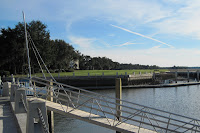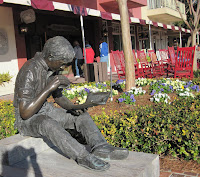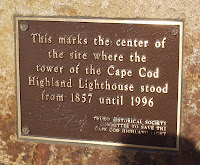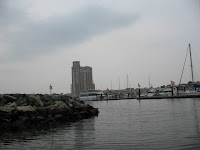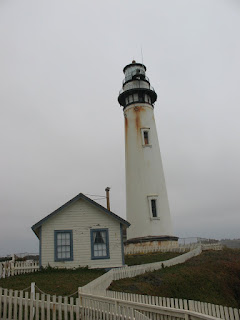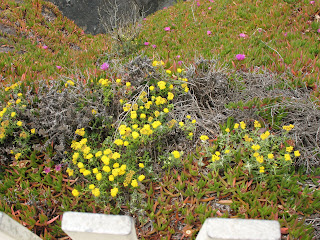Gay Head Light house from a distance. Gay Head lighthouse sits on a 130 foot cliff on Martha's Vineyard in Massachusettes. The lighthouse was established in 1799, though the current tower you see was built in 1856, and automated in 1960. It stands only 51 feet tall. The lighthouse is opened only for a few hours on Friday, Sat, and Sun from mid June to mid Setember for a fee in the evening, just before sunset. The cliffs and surrounding land are closed to the public due to erosion and unsafe conditions, thus the picture from a distance. The lens from the lighthouse is on display in the museum on Martha's Vineyard and played a large roll in guided many ships safely in the harbour. In August of 2009 President Obama and his family vacationed on Martha's Vineyard and toured the lighthouse which is located at the far western end of the island.
 Very little beach area exists at Gay Head, though it seems to be an area where one can, from time to time, see bathers in the buff. Apparently they feel they're far away when you're up above. The day we were there one lone couple walked the beach, he had his swim suit in hand. Though with the telescope provided at the look out that's not true, they are indeed visible. Perhaps they know that and like to flaunt? Beware if you visit with small children.
Very little beach area exists at Gay Head, though it seems to be an area where one can, from time to time, see bathers in the buff. Apparently they feel they're far away when you're up above. The day we were there one lone couple walked the beach, he had his swim suit in hand. Though with the telescope provided at the look out that's not true, they are indeed visible. Perhaps they know that and like to flaunt? Beware if you visit with small children.
English Explorer, Bartholomew Gosnold found the cliffs and named them Dover Cliffs in his journals. Though the name he used was not one that took hold. The gaily colorful cliffs were named Gay Head, a name that stuck. An Indian legend (Wampanog) tells the story of whales blood staining the cliffs, as the reason for the bright colorful cliffs. Through time, the cliff's have become mostly white, due to erosion and what took place way back from the ice age is what scientist indicate the source of colorful cliffs of long ago; rather than the story of whales blood after a long day's hunt.
 Very little beach area exists at Gay Head, though it seems to be an area where one can, from time to time, see bathers in the buff. Apparently they feel they're far away when you're up above. The day we were there one lone couple walked the beach, he had his swim suit in hand. Though with the telescope provided at the look out that's not true, they are indeed visible. Perhaps they know that and like to flaunt? Beware if you visit with small children.
Very little beach area exists at Gay Head, though it seems to be an area where one can, from time to time, see bathers in the buff. Apparently they feel they're far away when you're up above. The day we were there one lone couple walked the beach, he had his swim suit in hand. Though with the telescope provided at the look out that's not true, they are indeed visible. Perhaps they know that and like to flaunt? Beware if you visit with small children.English Explorer, Bartholomew Gosnold found the cliffs and named them Dover Cliffs in his journals. Though the name he used was not one that took hold. The gaily colorful cliffs were named Gay Head, a name that stuck. An Indian legend (Wampanog) tells the story of whales blood staining the cliffs, as the reason for the bright colorful cliffs. Through time, the cliff's have become mostly white, due to erosion and what took place way back from the ice age is what scientist indicate the source of colorful cliffs of long ago; rather than the story of whales blood after a long day's hunt.










